The Snapdragon 855 Performance Preview: Setting the Stage for Flagship Android 2019
by Andrei Frumusanu on January 15, 2019 8:00 AM EST- Posted in
- Mobile
- Qualcomm
- Smartphones
- SoCs
- 7nm
- Snapdragon 855
GPU Performance & Power
GPU performance of the new Adreno 640 in the Snapdrago 855 is interesting: The company’s performance claims were relatively conservative as they showcased that the new unit would perform only 20% better than its predecessor. This is a relatively low figure given that Qualcomm also advertises that the new GPU sees a 50% increase in ALU configuration, as well as of course coming on a new 7nm process which should give the SoC a lot of new headroom.
Before discussing the implications in more detail, let’s see the performance numbers in the new GFXBench Aztec benchmarks.
As a reminder, we were only able to test the peak performance of the phone as we didn’t have time for a more thorough sustained performance investigation.
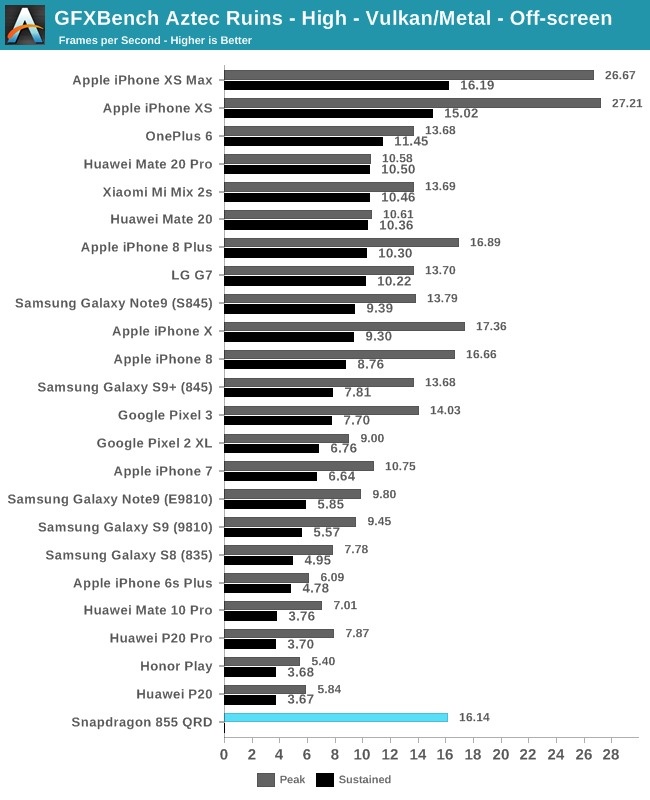
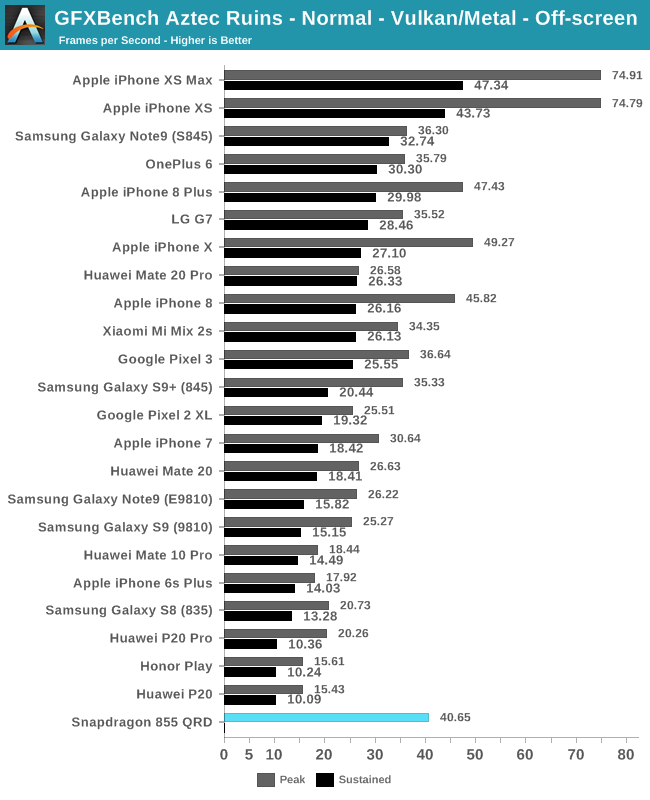
Both Aztec High and Normal results fall pretty much in line with Qualcomm’s advertised 20% improvement over the Snapdragon 845. Here the new chipset falls behind Apple’s A11 and A12 chips – although power consumption at peak levels is very different as we’ll see in just a bit.
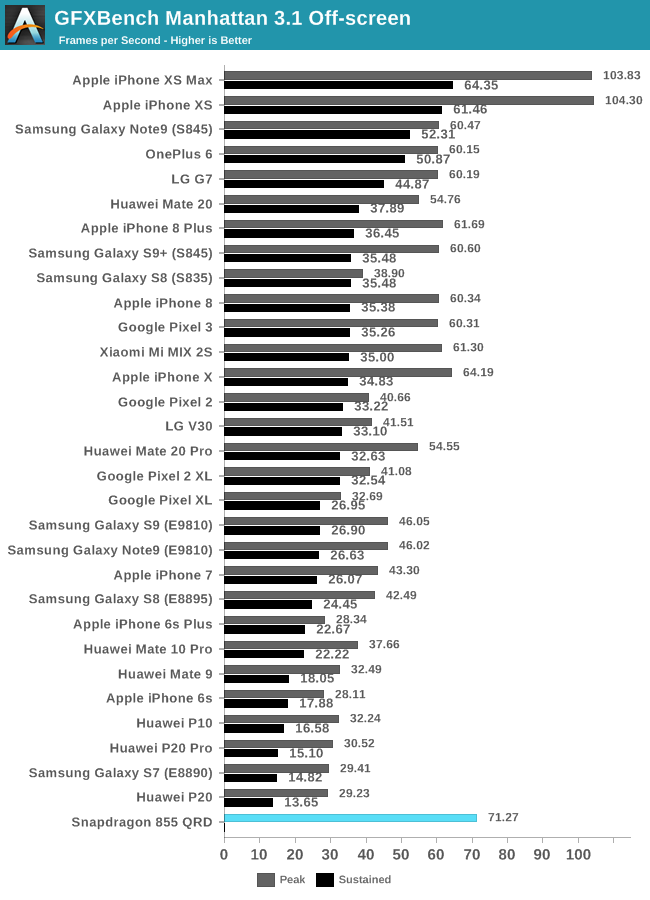
| GFXBench Manhattan 3.1 Offscreen Power Efficiency (System Active Power) |
||||
| Mfc. Process | FPS | Avg. Power (W) |
Perf/W Efficiency |
|
| iPhone XS (A12) Warm | 7FF | 76.51 | 3.79 | 20.18 fps/W |
| iPhone XS (A12) Cold / Peak | 7FF | 103.83 | 5.98 | 17.36 fps/W |
| Snapdragon 855 QRD | 7FF | 71.27 | 4.44 | 16.05 fps/W |
| Galaxy S9+ (Snapdragon 845) | 10LPP | 61.16 | 5.01 | 11.99 fps/W |
| Huawei Mate 20 Pro (Kirin 980) | 7FF | 54.54 | 4.57 | 11.93 fps/W |
| Galaxy S9 (Exynos 9810) | 10LPP | 46.04 | 4.08 | 11.28 fps/W |
| Galaxy S8 (Snapdragon 835) | 10LPE | 38.90 | 3.79 | 10.26 fps/W |
| LeEco Le Pro3 (Snapdragon 821) | 14LPP | 33.04 | 4.18 | 7.90 fps/W |
| Galaxy S7 (Snapdragon 820) | 14LPP | 30.98 | 3.98 | 7.78 fps/W |
| Huawei Mate 10 (Kirin 970) | 10FF | 37.66 | 6.33 | 5.94 fps/W |
| Galaxy S8 (Exynos 8895) | 10LPE | 42.49 | 7.35 | 5.78 fps/W |
| Galaxy S7 (Exynos 8890) | 14LPP | 29.41 | 5.95 | 4.94 fps/W |
| Meizu PRO 5 (Exynos 7420) | 14LPE | 14.45 | 3.47 | 4.16 fps/W |
| Nexus 6P (Snapdragon 810 v2.1) | 20Soc | 21.94 | 5.44 | 4.03 fps/W |
| Huawei Mate 8 (Kirin 950) | 16FF+ | 10.37 | 2.75 | 3.77 fps/W |
| Huawei Mate 9 (Kirin 960) | 16FFC | 32.49 | 8.63 | 3.77 fps/W |
| Huawei P9 (Kirin 955) | 16FF+ | 10.59 | 2.98 | 3.55 fps/W |
Switching over to the power efficiency table in 3D workloads, we see Qualcomm take the lead in terms of power efficiency at peak performance, only trailing behind Apple's newest A12. What is most interesting is the fact that the Snapdragon 855’s overall power consumption has gone down compared to the Snapdragon 845 – now at around 4.4W versus the 5W commonly measured in S845 phones.
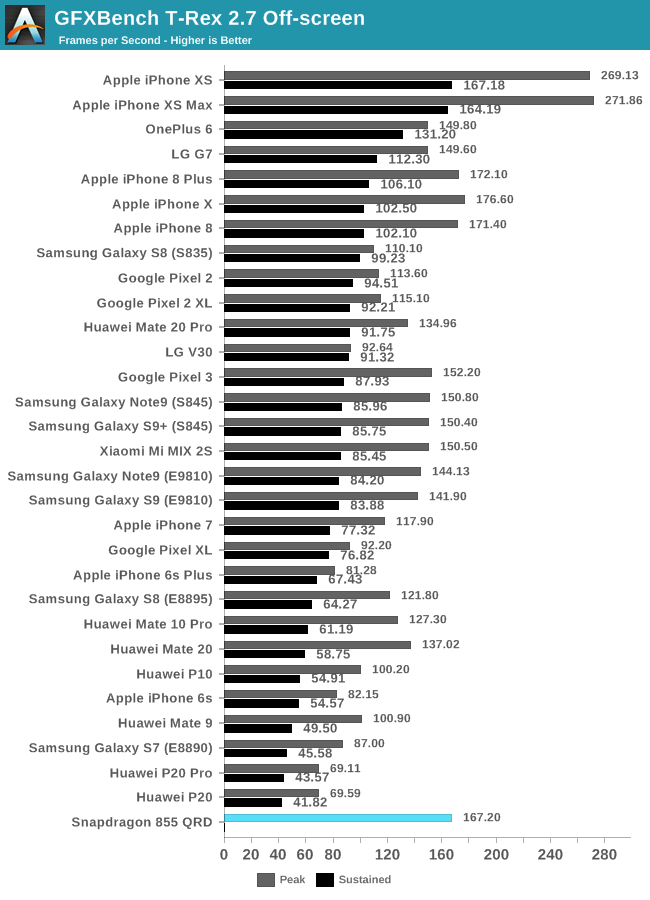
T-Rex’s performance gains are more limited because the test is more pixel and fill-rate bound. Here Qualcomm made a comment about benchmarks reaching very high framerates as they become increasingly CPU bound, but I’m not sure if that’s actually a problem yet as GFXBench has been traditionally very CPU light.
| GFXBench T-Rex Offscreen Power Efficiency (System Active Power) |
||||
| Mfc. Process | FPS | Avg. Power (W) |
Perf/W Efficiency |
|
| iPhone XS (A12) Warm | 7FF | 197.80 | 3.95 | 50.07 fps/W |
| iPhone XS (A12) Cold / Peak | 7FF | 271.86 | 6.10 | 44.56 fps/W |
| Snapdragon 855 QRD | 7FF | 167.19 | 3.83 | 43.65 fps/W |
| Galaxy S9+ (Snapdragon 845) | 10LPP | 150.40 | 4.42 | 34.00 fps/W |
| Galaxy S9 (Exynos 9810) | 10LPP | 141.91 | 4.34 | 32.67 fps/W |
| Galaxy S8 (Snapdragon 835) | 10LPE | 108.20 | 3.45 | 31.31 fps/W |
| Huawei Mate 20 Pro (Kirin 980) | 7FF | 135.75 | 4.64 | 29.25 fps/W |
| LeEco Le Pro3 (Snapdragon 821) | 14LPP | 94.97 | 3.91 | 24.26 fps/W |
| Galaxy S7 (Snapdragon 820) | 14LPP | 90.59 | 4.18 | 21.67 fps/W |
| Galaxy S8 (Exynos 8895) | 10LPE | 121.00 | 5.86 | 20.65 fps/W |
| Galaxy S7 (Exynos 8890) | 14LPP | 87.00 | 4.70 | 18.51 fps/W |
| Huawei Mate 10 (Kirin 970) | 10FF | 127.25 | 7.93 | 16.04 fps/W |
| Meizu PRO 5 (Exynos 7420) | 14LPE | 55.67 | 3.83 | 14.54 fps/W |
| Nexus 6P (Snapdragon 810 v2.1) | 20Soc | 58.97 | 4.70 | 12.54 fps/W |
| Huawei Mate 8 (Kirin 950) | 16FF+ | 41.69 | 3.58 | 11.64 fps/W |
| Huawei P9 (Kirin 955) | 16FF+ | 40.42 | 3.68 | 10.98 fps/W |
| Huawei Mate 9 (Kirin 960) | 16FFC | 99.16 | 9.51 | 10.42 fps/W |
Again switching over to the power and efficiency tables, we see that the Snapdragon 855 is posting a ~30% efficiency boost over the Snapdragon 845, all while slightly improving performance.
Overall, I’m very happy with the initial performance and efficiency results of the Snapdragon 855. The S845 was a bit disappointing in some regards because Qualcomm had opted to achieve the higher performance figures by increasing the peak power requirements compared to exemplary thermal characteristics of the Snapdragon 835. The new chip doesn’t quite return to the low power figures of that generation, however it meets it half-way and does represent a notable improvement over the Snapdragon 845.


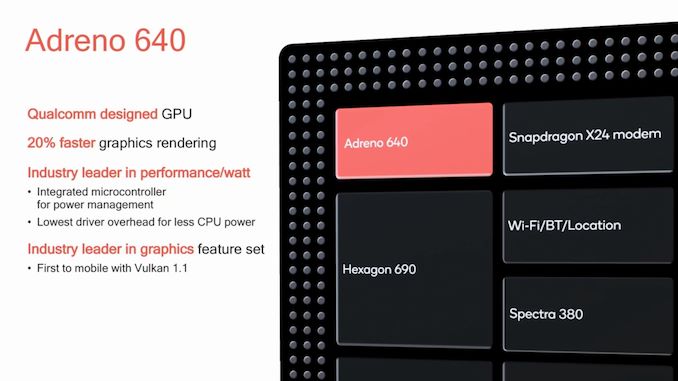








132 Comments
View All Comments
cknobman - Tuesday, January 15, 2019 - link
So better power consumption but performance wise it looks like a swing and a miss.Nothing too meaningful over the 845.
IGTrading - Tuesday, January 15, 2019 - link
To be honest, this is good enough for me and most of us.I'd be happy to see Qualcomm focusing more on server CPUs and computers/notebook running Windows on AMR chips.
It's been something like 15 or even 20 years since coders/developers stopped worrying about optimizations, performance improvements and now they only rely on the much improvement hardware being available year after year.
We were building optimized web pages 20 years ago, that looked good and loaded in less than 10 seconds on a 5,6 KB connection.
Now idiots build sites where the Home Page is 300 MB heavy and complain about mobile CPUs and mobile networks not being fast enough.
bji - Tuesday, January 15, 2019 - link
"t's been something like 15 or even 20 years since coders/developers stopped worrying about optimizations, performance improvements and now they only rely on the much improvement hardware being available year after year."Speaking as a software developer, I will say that your statement is bullshit. I have yet to work on any product where performance wasn't considered and efforts to improve efficiency and performance weren't made.
bji - Tuesday, January 15, 2019 - link
Also everything your browser does now is 10,000 times more complicated than anything that browsers did 20 years ago. All of the effort that has gone into developing these technologies didn't go nowhere. You are just making false equivalencies.And if a page took 5 seconds to load in 2019, let alone 10 seconds, you'd be screaming about how terrible the experience is.
name99 - Tuesday, January 15, 2019 - link
It's usually the case that people talking confidently about what computers were like 20 yrs ago (especially how they were faster than today...) are in the age range from not yet born to barely five years old at the relevant time.Those of us who lived through those years (and better yet, who still own machines from those years) have a rather more realistic view.
rrinker - Wednesday, January 16, 2019 - link
Really? What's the 'realistic' view? For background, the first computer I had regular access to was a TRS-80 Model 1 when they first came out in 1977, so I've been doing this a LONG time. Software today is a bloated mess. It's not all the programmers' fault though, there is this pressing need for more and more features in each new version - features that you're lucky if 1% of the users actually even utilize. Web pages now auto start videos on load and also link a dozen ads from sites with questionable response times. That would have been unthinkable in the days 56k and slower dialup, and it just wasn't done. I even optimized my BBS in college - on campus we had (for the time) blazing fast 19.2k connections between all dorm rooms and the computing center, at a time when most people were lucky to have a 1200bps modem, and the really lucky ones had the new 2400s. So I set up my animated ANSI graphic signons in a way that on campus users at 19.2k would get the full experience and off campus users, connecting via the bank of 1200 baud modems we had, would get a simple plain text login. In today's world, there is a much grater speed disparity in internet connections. I have no problem with pretty much any site - but I have over 250mbps download on my home connection. Go visit family across the state - the best they can get a a DSL connection that nets about 500k on a good day on a speed test - and so many sites fail to load, or only ever partially load. But there are plenty of sites that don;t try to force graphics and videos down your throat that still work fine.No, things weren't faster back in the day - but because the resources were more limited, both for apps running on the local computer in terms of RAM, storage, and video performance as well as external connectivity, programs had to be more efficient. Heck, the first computer I actually owned had a whole 256 bytes of RAM - to do anything I had to be VERY efficient.
Klinky1984 - Friday, January 18, 2019 - link
So pay per minute slow internet, the non-standard compliance of Netscape 2.0 and IE 3.0, an internet without any video streaming, were there "good ol days"? Sorry but I remember bloated pages that took a minute plus to download or never loaded. I remember waiting 3 minutes for one single high res jpeg to download... They were not glory days. Can your 256 byte computer even handle Unicode? No way.seamadan - Tuesday, January 22, 2019 - link
I bet your pages looked REALLY good. Like REALLY REALLY good. I'm in awe and I haven't even seen themKrysto - Tuesday, January 15, 2019 - link
That bold has sailed. They've already given all the server IP on a silver platter to their forced Chinese "partner".That said, Snapdragon 8cx for notebooks does look quite intriguing, mainly because of its 10MB shared cache.
Krysto - Tuesday, January 15, 2019 - link
boat*